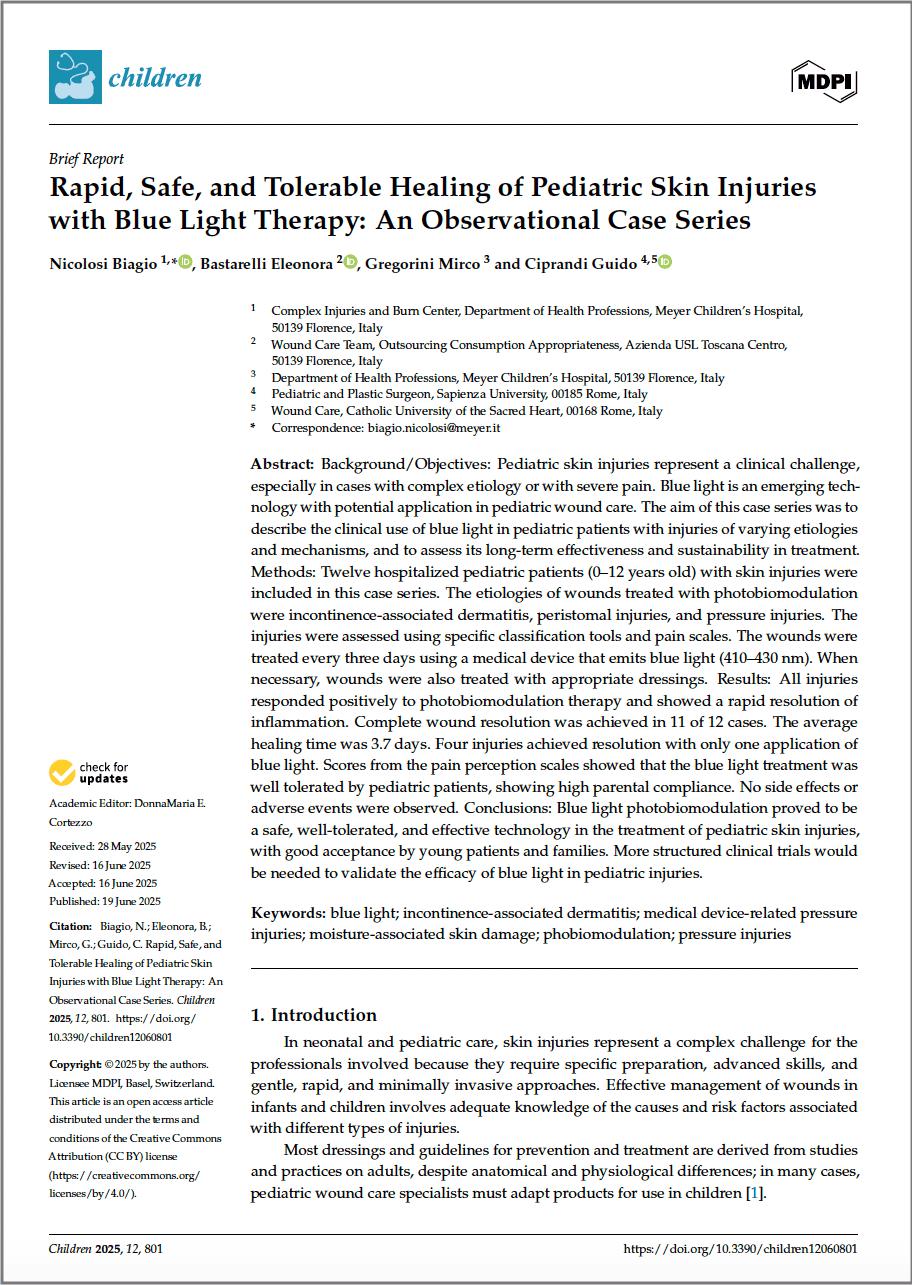
Blue light in the treatment of pediatric skin injuries
Case series published in the Children journal
Title: Rapid, Safe, and Tolerable Healing of Pediatric Skin Injuries with Blue Light Therapy: An Observational Case Series.
Authors: Biagio Nicolosi, Eleonora Bastarelli, Mirco Gregorini, Guido Ciprandi.
Year: 2025
Publication: Children (Basel). 2025 Jun 19;12(6):801. doi: 10.3390/children12060801.
PEDIATRIC SKIN INJURIES CASE SERIES | SUMMARY
INTRODUCTION
In neonatal and pediatric care, skin injuries represent a complex challenge for the professionals involved because they require specific preparation, advanced skills, and gentle, rapid, and minimally invasive approaches. Most dressings and guidelines for prevention and treatment are derived from studies and practices on adults, despite anatomical and physiological differences; in many cases, pediatric wound care specialists must adapt products for use in children. Infant skin differs from adult skin in structural and functional terms, and although anatomically mature, it is a more delicate and vulnerable structure. One of the goals of integrated wound management in pediatric subjects is to minimize pain and reduce emotional distress for both patients and parents.
In recent years, photobiomodulation with Blue Light has shown an important impact on healing chronic wounds of different etiologies in adults. Blue Light acts through the reduction of inflammation and stimulation of microcirculation, promoting tissue regeneration and pain reduction. Blue Light therapy involves contactless treatment and is neither invasive nor painful, so it could be a viable treatment option for pediatric patients. This case series aims to assess efficacy and sustainability of Blue Light therapy in pediatric settings.
MATERIALS AND METHODS
The patients included in this case series were treated or hospitalized at Meyer Children’s Hospital, Florence (Italy). All patients were treated by pediatric nursing staff experienced in wound care, who also collected data on the skin injuries treated with blue light. Twelve pediatric patients (0–12 years old) suffering from incontinence-associated dermatitis (IAD) (4), peristomal moisture-associated skin damage (pMASD) (4), pressure injuries (PIs) (1), and medical device-related pressure injuries (MDRPIs) were enrolled. Skin injuries were assessed using validated classification tools and age-appropriate pain scales.
For Blue Light photobiomodulation was used the EmoLED medical device, indicated for skin injuries in individuals over 16 years of age. In the context of this study, the use of the device was considered off-label, as is often the case for medical devices in pediatric populations. The treatment consisted of blue light irradiation for 60 or 120 s, applied to the skin injure surface after cleansing and before dressing. Dressing selection was based on wound type, exudate level, anatomical site, and patient age, in accordance with best clinical practices and pediatric wound care principles. The frequency of dressing changes varied according to wound characteristics and exudate level but was generally performed every 3 to 4 days in most cases.
RESULTS
Eight males and four females were treated; four patients were newborns less than 1 month old, three patients were infants between 4 and 7 months old, and the remaining patients were older than 9 years old (9–12). The skin injuries examined were 4 IAD, 4 p-MASD, 1 PI e 3 MDRPI.
Complete skin injure resolution was achieved in 91.6 percent of cases (11 of 12), while partial healing was found in an infected p-MASD with surgical wound complication who had only two treatments with Blue Light but still showed significant clinical improvement.
The average healing time was 3.7 days. IADs and p-MASDs healed with only 1 to 2 Blue Light treatments, while 2 to 4 applications were needed for pressure injuries.
The evaluation of perceived pain was assessed in all cases according to different scales, depending on the age of the child. The newborns showed signs of mild agitation, with no evidence of pain. The scores indicated discomfort, characterized by mild restlessness, but there was no need for analgesic intervention. Older children reported no pain, and facial descriptions indicated slight differences in expression, attributable to moderate agitation or restlessness, but with no evidence of distress.
No side effects or adverse events were observed.
In the article is reported a detailed description of four cases that provides an understanding of the different clinical conditions faced.
DISCUSSION
To the best of our knowledge, this work is the first one to evaluate photobiomodulation with LED blue light in pediatric wound care.
In our experience, all patients treated with Blue Light photobiomodulation showed positive results in response to treatment. In 11 out of 12 cases, the injuries achieved full healing in shorter times compared to those commonly reported in the literature. Thirty-three percent (4) of the injuries achieved resolution with only one application of Blue Light. One treatment effect we noticed in all cases was the rapid resolution of inflammation, which allowed the injured tissue to proceed with repair more quickly.
Scores from the pain perception scales showed that the Blue Light treatment was well tolerated by pediatric patients who showed only discomfort or agitation, probably related to the staff manipulation rather than treatment with the medical device. Therefore, the therapy was well accepted by patients, also showing high parental compliance. No adverse events or side effects were observed during the blue light application, confirming the safety already established in adults.
This case series shows limitations such as the small number of patients and the variability of dressings associated with blue light treatment and the absence of a control group. However, according to the authors’ conclusions, the strengths of Blue Light therapy are its adaptability to a wide variety of skin injures, the absence of side effects, and its suitability for use in pediatric settings.

